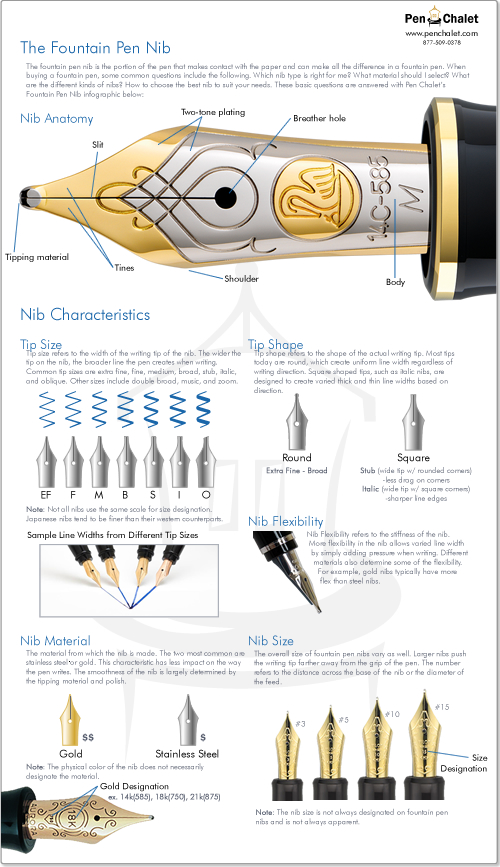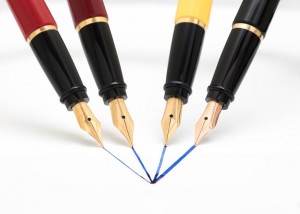Embed the Fountain Pen Nib Infographic
Details of the Fountain Pen Nib Infographic
When selecting a fountain pen of the most important things to look at is the nib. With all of the choices available with different tip sizes, materials and characteristics this process can be confusing. We created this basic infographic about the fountain pen nib to assist you in your search for the best nib for your needs.
What is a Fountain Pen Nib?
First, what is a fountain pen nib? The fountain pen nib is the actual part of the pen that makes contact with the paper. It is a tapered piece of metal through which the fountain pen ink flows onto the paper. Refer to the section on nib anatomy for individual parts of the nib. When selecting a fountain pen nib consider the following characteristics.
Tip Size
The tip size refers to the width of the tip of the nib. The wider the nib, the wider line the pen will write. The tip size on the nib is one of the biggest characteristics of a nib that will effect how the pens writes. Choosing a tip size depends on what you intend to use the pen for as well as your writing style. Smaller tip sizes are great for everyday use as well as smaller writing. Wider tips are good if you wish to create line variation when writing. Line variation is when one direction of writing is thicker than the other, for instance vertical strokes are wider than horizontal strokes. Line variation is most altered by the tip shape which we will discuss in the next section.
Common fountain pen nib tip sizes include extra fine(EF), fine(F), medium(M), and broad(B). Other sizes include stub(S), italic(I), music(M) and zoom(Z).
Things to consider
- Narrower nibs tend to be scratchier than broader nibs. Narrower nibs have a sharper tip that lays down less ink and can drag on the paper. Wider nibs have more ink that helps lubricate as the pen writes creating a smoother writing experience.
- The size designation for Japanese nibs tend to be finer than European or Western brand nibs. When selecting a Japanese pen you may want to select a slightly wider nib.
Tip Shape
The shape of the nib will drastically effect the style of writing. Tips shapes come in either round or square. Round shaped tips can vary in size with wider tips creating wider line thicknesses. Round shaped nibs are best for everyday use and are designated from extra fine to broad.
Square shaped tips, also referred to as italic, stub or calligraphy nibs, are designed to alter the line thickness with the direction the the stroke. Italic nibs are made with sharp edges on the outside of each tine while with a stub nib the outer edges of the tines have a slight rounded edge. This rounded edge creates a smoother writing experience because the edges do not catch the paper. An italic nib will have sharper line edges than a stub nib. Italic nibs vary in width as well typically from 1.1mm to 1.9mm.
Another nib tip shape is an oblique nib. Round and square shaped nibs have equal length tines. An oblique nib will have the tines cut an angle so the outsides edges of the tines are different lengths.
Things to consider
- What is your writing style and what is your desired output. Is the pen for everyday writing or do you want a little style with your writing?
Nib Material
The material which the nib is made from can effect the writing experience but not as much as the nib shape and size. Most common materials today for nibs are stainless steel and gold. Stainless steel nibs are stiffer than their gold counterparts. Gold nibs are not necessarily better than stainless steel nibs. Many stainless steel nibs are “tipped” with gold, iridium or another metal so the writing tip that makes contact with the paper becomes smoother and comparable to gold.
Things to consider
- Price. Since gold is a precious metal they cost more than stainless steel.
- Color does not designate the material. Some stainless steel nibs are gold in color. Look for the designation on the nib.
Nib Flexibility
One of the last features to cover is nib flexibility. This simply means how much the nib bends when pressure is applied. Stiff nibs will bend very little with pressure while a flexible nib is just the opposite. Very flexible nibs are called a wet noodle. As the writer applies pressure the tines on the nib separate creating a wider line and more variation. Fountain pen nibs today mainly have little or no flexibility. Some pens come with soft nibs or with flex nibs such as the Namiki falcon or even more flex with the Pilot Custom 912 with an FA nib.
Overall Nib Size
The nib size refers to the overall size of the nib. This characteristic dos not play much in the performance of the nib other than the larger the nib the more distance there is from the grip to the writing tip. The nib sizes are designed numerically, the most common sizes from #3 to #15, with larger numbers as the nib increases in size.
Nib Swap
Some brands will sell their fountain pen nibs separately making it possible to swap or change the nib to different sizes and materials. Many however do not allow their nibs to be sold without the pen. Other brands such as Pelikan offer a free nib exchange on their fountain pens within the first 30 days after ordering. If you are unsure of the size and type of nib you want you may consider one of these options when making your purchase.
Fountain Pen Infographic Conclusion
There are many characteristics of fountain pen nibs but these are the biggest factors to consider when making your choice. Hopefully this fountain pen nib infographic and guide help selecting the right fountain pen nib. If you have any questions feel free to reach out to us and we can help you make the choice that is best for you and your needs.
Fountain Pens
Buy Fine Pens
Best Fountain Pen Ink
Pen Brands
Sailor Pen Company
Pilot Pen Company
Lamy Fountain Pens







A lot of great information here! Thanks, Pen Chalet!
I liked your post and I am regular reader of your blog. The information you shared will help me provide a good knowledge. Thanks for sharing this post.
Wow very beautiful and such an informative article. Myself just fallen in love with fountain pens and this article gives good ideas about choosing the nib size. Thanks a lot.